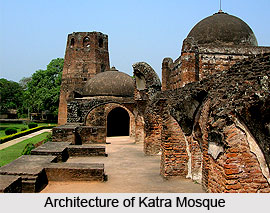 Architecture of Katra Mosque, which lies in the north-eastern part of Murshidabad, West Bengal comprises double-storied domed cells, built with an aim to accommodate readers of the Holy Quran in that point of time. The brick-made mosque is also termed as `Katra Masjid` and is existent over a high square platform. About 700 Quran readers can seek refuge in its rooms, which also makes it a kind of `madrasa` and the rooms are clustered around a gigantic courtyard, based at the anterior portion of these rooms. The four corners are decorated with four large minars which are octagonal and slightly narrow towards the upper end. The towers over the minarets measure about 70 feet in height and 25 feet in diameter and the entire mosque is quadrangular, devoid of pillars as their foundations. Constructed between 1723 and 1724, the mosque contains the mortal remains of the Nawab Murshid Quli Khan.
Architecture of Katra Mosque, which lies in the north-eastern part of Murshidabad, West Bengal comprises double-storied domed cells, built with an aim to accommodate readers of the Holy Quran in that point of time. The brick-made mosque is also termed as `Katra Masjid` and is existent over a high square platform. About 700 Quran readers can seek refuge in its rooms, which also makes it a kind of `madrasa` and the rooms are clustered around a gigantic courtyard, based at the anterior portion of these rooms. The four corners are decorated with four large minars which are octagonal and slightly narrow towards the upper end. The towers over the minarets measure about 70 feet in height and 25 feet in diameter and the entire mosque is quadrangular, devoid of pillars as their foundations. Constructed between 1723 and 1724, the mosque contains the mortal remains of the Nawab Murshid Quli Khan.
An earthquake in the year 1897 demolished the Katra Mosque. Every minar of the mosque is connected to a spiral staircase with the aide of which visitors can reach the terrace, from where they can enjoy spectacular view of the majority of Murshidabad. Nawab Murshid Quli Khan is buried under the series of steps which are existent near the entrance of Katra Mosque. This was created to pay respect to the last wishes of the emperor who had claimed that he regretted his sins and had ordered it out of modesty. The objective of the ruler was to be buried in an area which would receive the footprints of innumerable noble and holy men who treaded into the mosque and climbed its stairs. Therefore, following the death of Murshid Quli Khan in 1725, his remains were buried underneath the stairs. There exists a slab at the top of the mosque which contains an Arabic inscription which states: "Muhammad, the Arabian, the glory of both worlds. Dust be on the head of him who is not the dust of his portal".
This rectangular-shaped mosque measures about 45.5 metres in length and 7.32 metres in width. The mosque consists of five bays, each equipped with an arched gateway and a beautiful turret is present at the central bay. Five domes of the mosque have still survived the 1897 earthquake which destroyed the major portion of the mosque. Katra Mosque occupies an area measuring 19.5 acres. Six arched gateways exist in each of the cells of the mosque. There are about 15 stairs which lead to the arched gate, comprising five arches. The roof in front of Katra Mosque measures 166 feet by 110 feet and there exists a Hindu temple dedicated to Lord Shiva in the premises of the mosque.





















